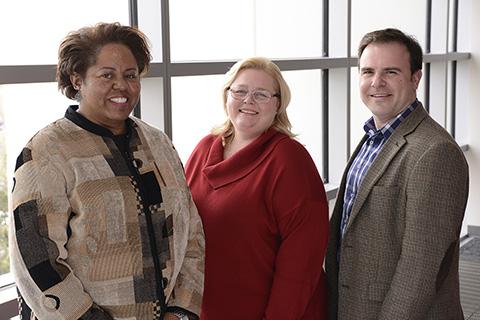Technology transfer at national laboratories presents challenges, and the Frederick National Laboratory is no exception. But that hasn’t stopped Claudia Haywood, Tom Sova, and Candice Garner-Groves from notching a series of accomplishments that span their tenure at FNL.
“You can see [the challenges] as large hurdles, or you can see them as small hurdles,” said Haywood, D.P.A., director of FNL’s Office of Intellectual Property and Strategic Agreements (IP&SA). “And I have consciously made a choice, honestly, to see them as puddles.”
Sova is a senior technology transfer manager and a registered patent attorney, while Garner-Groves is a legal assistant. They, under Haywood’s leadership, help operate FNL’s IP&SA, which negotiates and executes external collaborations, protects employees’ invention rights, and handles a range of other copyright-related tasks.
“Everything we’re doing is to advance [FNL’s] relationships with the external community,” said Haywood.
Despite the trio’s extensive legal expertise, the puddles they encounter occasionally seem like oceans. Demand for IP&SA support has steadily increased as FNL continues to grow as a national laboratory, but at times the appropriate negotiating tools, transactions, and legal apparatus haven’t been consistently available to IP&SA.
Haywood recalls an instance in 2015 when the office helped establish and launch the European Union Nanomedicine Characterisation Laboratory, an international research facility patterned after the FNL Nanotechnology Characterization Laboratory funded by NCI. At the time, a contractor Cooperative Research and Development Agreement (cCRADA) was the only tool available to make the project happen—and it still wasn’t a perfect fit.
“Taking the government tools available for strategic partnering and trying to use them for nine different groups—seven of which were European—was a challenge,” Haywood said.
Even so, the project was successfully negotiated and is ongoing at FNL.
In the past seven years alone, IP&SA executed 35 cCRADAs that garnered more than $7 million in revenue to fund FNL’s research activities and leverage the support provided by NCI. Unlike NCI’s governmental CRADAs, cCRADAs allow FNL to collaborate with external partners independently of government participation. But NCI still benefits—as FNL’s sponsor, it receives license rights and access to technologies, data, and materials developed under the partnerships.
In addition to the cCRADAs, IP&SA implemented hundreds of strategic agreements to support FNL scientists and their external collaborators, who were then able to conduct research, share data, and beta test a collaborator’s prototype scientific equipment, among other tasks.
The team also protects FNL employees’ intellectual property. According to Sova, the office has secured better intellectual property protections and sought to ensure that FNL’s intellectual property has strong indemnification rights and warranties in its partnerships and collaborations.
A Perfect Fit
For Haywood, Sova, and Garner-Groves, working at FNL has been a rewarding experience and a high point of their careers.
Haywood, a practicing attorney in Maryland, came to FNL from a 20-year career that spanned research administration and technology transfer. She worked at several institutions, including the University of Maryland Biotechnology Institute, the Space Telescope Science Institute, and the J. Craig Venter Institute. While at the University of Maryland, she obtained her J.D., and she has since obtained her doctoral degree in public administration from the University of Baltimore.
Haywood joined FNL seven years ago because she was curious about its capabilities and potential to drive cancer research. Today, she remains excited about the FNL-led national research initiatives, some of which IP&SA helped to implement.
Sova, also a practicing attorney in Maryland, earned an undergraduate degree in biology but chose to attend law school because he didn’t feel drawn to a medical profession or scientific research. After obtaining his J.D., he worked as a judicial clerk, litigation attorney, and patent attorney. He later obtained a master’s degree in biology and has worked across the biotechnology industry supporting contracts and intellectual property.
“[Patents] ended up being a really great fit for my body of knowledge, the legal side plus the science side,” Sova said, adding that patent attorneys are required to hold a degree in a scientific discipline. “It’s sort of a dream job for me.”
Haywood and Sova consider Garner-Groves to be the “glue that keeps it all together.” A graduate of Montgomery College’s Paralegal Studies Program, she began her career at a Gaithersburg law firm, where she eventually worked her way up to legal assistant. She specialized in criminal, domestic, estate planning, and personal injury law, but after transitioning to the J. Craig Venter Institute, she realized that science and technology were a better fit.
“It was a natural progression to move from the JCVI to the FNL,” she said of her transition six years ago. “Both cancer and AIDS have affected my life personally and have taken away people that I love. What better place to be than here?”


